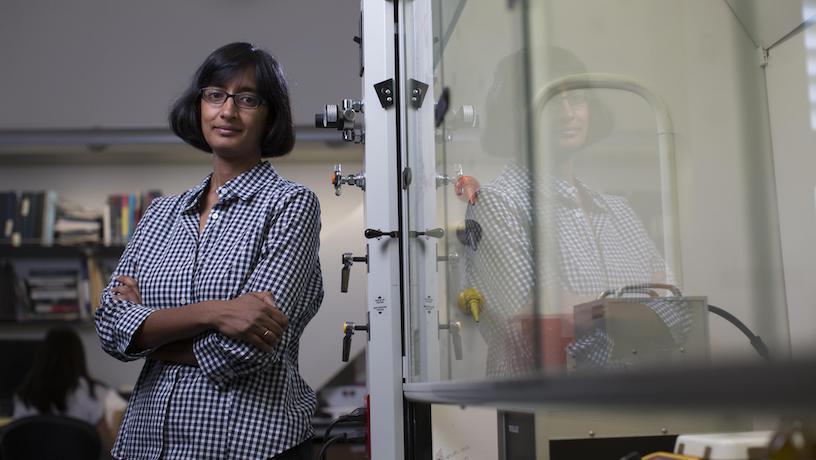Columbia Wins $1.8M NSF Grant for CCI Phase 1 Center for Chemistry with Electric Fields
Led by Applied Physics Prof. Latha Venkataraman with Department of Chemistry colleagues, the new ChEF center will focus on developing methods to use electric fields control and facilitate chemical reactions

A team led by Latha Venkataraman together with Department of Chemistry faculty Timothy Berkelbach, Colin Nuckolls, Tomislav Rovis, and Xavier Roy, has won a three-year $1,800,000 grant from the National Science Foundation (NSF) to build the NSF Center for Chemistry with Electric Fields (ChEF). Supported by the Centers for Chemical Innovation Program of the NSF’s Division of Chemistry, the Phase 1 Center will focus on using directional electric fields to understand, control, and manipulate chemical transition states to alter the outcomes of chemical reactions.
“Chemistry is at the center of the nanoscience revolution,” says lead PI Venkataraman, Lawrence Gussman Professor of Applied Physics, professor of chemistry, and Vice Provost for Faculty Affairs. “By bringing together a team of like-minded scientists from a diverse set of backgrounds, we will create a new field of study that will transform reaction chemistry. We expect to create a new paradigm for molecular construction: molecules, pathways, and intermediates that were not possible with traditional catalysis will now be accessible through our new center’s research.”
The researchers, who have a broad range of expertise in synthesis, measurement, and computation, will use their complementary expertise to gain a molecular-level understanding of electric field-driven catalysis, and to use this insight to drive chemical reactions, control reaction kinetics, and modulate thermodynamics. They will explore a range of reactions that show promise through quantum computations, and utilize scanning probe techniques to apply large and directional electric field during the reaction. The overarching goal of the team is to demonstrate that an oriented electric field can completely alter the reaction trajectories and pathways, achieving transformations not possible under traditional conditions.
The ChEF will also collaborate with Merck and Columbia Technology Ventures to get effective new techniques from the lab to the marketplace. There will also be broad outreach to students, including undergraduates, together with a partnership with the Harlem Children’s Zone School in New York City to expand the excitement of chemistry to K-12 underrepresented groups.
“Our new center will explore the concept and scope of how to use electric fields to control chemical reactions and provide sustainable and green pathways to synthesis,” notes Venkataraman, whose experimental group is expert in measuring electronic, mechanical, optical, and thermoelectric properties of single-molecule circuits.”
Berkelbach, who runs a computational group at Columbia and the Flatiron Institute, adds, “As a computational research group, we're thrilled to integrate with such a diverse group of experimental scientists who will drive our theoretical developments and test our predictions.”
“The Center will enable us to explore orthogonal modes of activation and bond construction,” states Rovis, whose group works on transition metal and photoredox catalysis strategies for organic synthesis. “In addition to the plethora of tools we have already, we will add directional electric fields. The possibilities are endless.”
